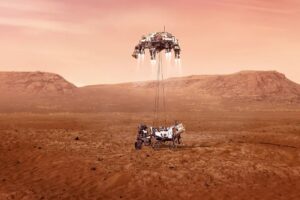The Perseverance rover is NASA’s current Mars exploration rover that is still in operation, and is looking forward to completing its mission to find and confirm previously speculated life signs on Mars that could have existed.
It is the successor of the Curiosity rover that first discovered the possibility of life having existed on Mars prior to its atmosphere and conditions turning into the way they are now, and it also hopes to complete its mission by successfully bringing back Martian samples back to Earth for detailed study.
When was the NASA’s Perseverance Rover launched? (When did it land)
The rover, part of NASA’s 2020 Mars mission, was launched on 30 July 2020, and landed successfully on 18 February 2021. Since then, the rover has been active for around 347 earth days (until 10 February 2022) and is still scanning the nearby areas of the crater Jezero in which it landed, and sending back valuable data.
Related: What’s Noteworthy About NASA Artemis Mission?
What’s the objective of NASA’s Perseverance Rover & how will it accomplish?
As it travels, Perseverance collects soil and rock samples, which it stores in tubes for future NASA and European Space Agency missions to gather. Many sorts of laboratory tests can’t be conducted in space or can’t be done very precisely, despite technical breakthroughs in producing compact, low-power research instruments for space missions. The mission is anticipated to cost $2.7 billion.

In rocks created during Mars’ warm, wet past, the rover is looking for microbial remains. It will also seek for carbon-containing chemicals, organics that comprise the building blocks of life on Earth. Since 1976, when the twin Viking landers conducted long-shot chemical experiments that yielded unsatisfactory findings, NASA has not explicitly looked for life on Mars.
What is the Ingenuity helicopter?
Perseverance’s belly contained Ingenuity, a miniature helicopter drone. Perseverance dropped Ingenuity to the surface and walked 100 metres away after they arrived on Mars. Since then, Ingenuity has flown many times to explore the rover’s surroundings. Ingenuity isn’t tied to Perseverance’s mission success as a technology demonstration, but it is teaching us valuable lessons about the feasibility of flying vehicles on other worlds.
Curious Read: What’s the Recent Radio Signal, receiving from space per 18 min?
On April 19, two months after the Perseverance rover landed, Ingenuity performed the first powered controlled interplanetary flight by an aircraft, lifting off vertically, hovering, and landing for a total flight time of 39.1 seconds. The helicopter has completed 19 successful flights as of February 8, 2022.
What’s all the NASA’s Perseverance Rover carrying with it? (The Send Your Name Mars Campaign)
NASA’ organised its “Send Your Name to Mars” campaign, in which people from all around the globe were asked to submit their names to ride on NASA’s next rover to Mars. 10,932,295 names were submitted, and the names, along with the essays of the 155 finalists in NASA’s “Name the Rover” contest, were etched onto three fingernail-sized silicon chips using an electron beam.
What are some NASA’s other important missions to Mars ?
- Mariner series orbiters1970s)
- Viking Program –Viking 1 &2(1975)
- Mars Pathfinder, Sojourner rover(1997)
- Mars orbiter Surveyor (1996-2006)
- Mars Reconnaissance orbiter(2005 -06)
- Curiosity rover (2011-present)
- Perseverance rover (2020-present)
Recent: Why is it Complex to Build Space Station On Moon?
Some other facts and accomplishments of the NASA’s Perseverance Rover
- On 4 February 2021, the rover completed the longest ever Martian drive completed in a single Martian day, travelling 806.3 feet or 245.76 meters. It is also the fastest rover currently on Mars.
- The Ingenuity helicopter has become the first to make a powered interplanetary flight ever.
- The rover carries special microchips including 10.9 million names and 155 essays submitted to the space agency as part of competitions to name the rover or send names to Mars.
- The spacecraft also contains a reference to the Covid epidemic, which has had an impact on the mission’s preparations and operations on Earth.
- In honor of the work of frontline medical workers during the pandemic, an aluminium plate on the rover bears an image of the Rod of Asclepius, the ancient Greek symbol for healing and medicine, supporting the Earth.
- The pattern on the parachute’s outer edge is also thought to reflect 34°11’58” N 118°10’31” W, the geolocation code for the Jet Propulsion Laboratory, which was responsible for most of Perseverance’s development.
Conclusion and Upcoming Plans
The Perseverance rover has been a success until now, and is still continuing on its mission to find evidence or precursors to life or previous life signs on the planet.
NASA plans to organize another mission to take the samples that have been collected by the rover, and bring them safely back to Earth for detailed study, which will conclude the main mission of the Perseverance rover project.
What’s More to Know–
